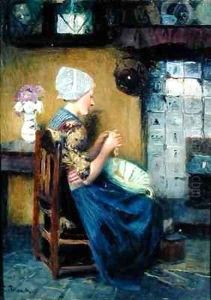Karl Duxa Paintings
Karl Duxa was a notable figure in the European art scene, particularly recognized for his contributions during the late 19th and early 20th centuries. Born in 1871, Duxa's artistic journey began in a period marked by rapid changes and developments in the arts, amidst the vibrant cultural milieu of Europe. His career spanned a time of significant evolution in art styles, witnessing the transition from the traditional approaches of the 19th century to the more experimental and diverse techniques that characterized the early 20th century.
Duxa's body of work predominantly reflects the influences of the movements active during his lifetime, including Impressionism, Expressionism, and early Modernism. Although not as widely recognized as some of his contemporaries, Duxa made substantial contributions to the art world through his exploration of color, form, and the emotional depth of his subjects. His paintings often depicted scenes from everyday life, landscapes, and portraits, imbued with a sense of realism and a keen eye for detail.
Throughout his career, Karl Duxa remained committed to evolving his style and technique, demonstrating a versatility that allowed him to navigate through the changing artistic landscapes of his time. He participated in several exhibitions, gaining respect and admiration from his peers and the art-loving public alike. Despite the challenges of working in an era that saw the world go through significant turmoil, including World War I, Duxa's dedication to his art remained unwavering. He continued to produce works that resonated with the themes of human experience, nature, and the complexities of the modern world.
Duxa's legacy, though perhaps not as celebrated as that of some of his contemporaries, remains an important part of the tapestry of early 20th-century European art. His contributions helped pave the way for future generations of artists, and his works continue to be appreciated by those who seek to understand the evolution of art during one of its most transformative periods. Karl Duxa passed away in 1935, leaving behind a rich portfolio of artworks that continue to inspire and captivate art enthusiasts and historians.

